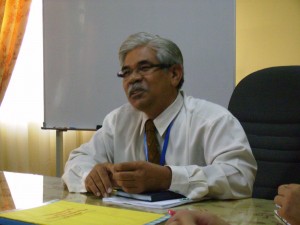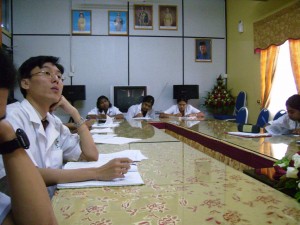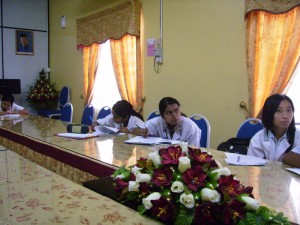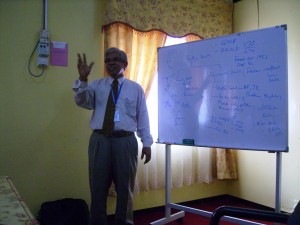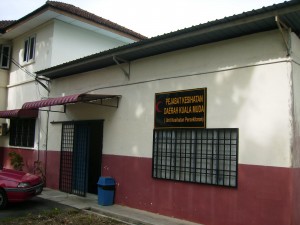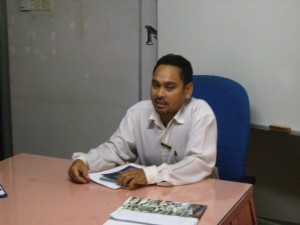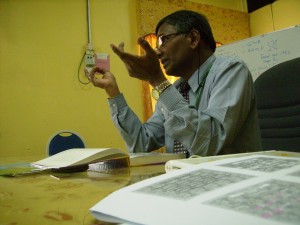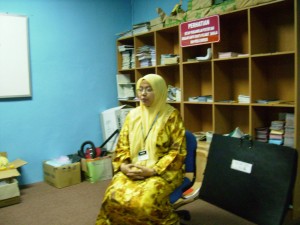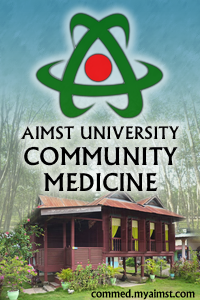Monday, July 28, 2008
KMDHO TEAM LOADED WITH FACTS AGAIN AND AGAIN BUT ENDS THE DAY WITH THEIR 1ST FIELD WORK!
KMDHO team gathered in meeting room by 8.30am. We were loaded once again with facts on the organisation chart and the function of each units but this time more specifically on the job functions of Environmental Health. The lecture was given by the Chief Ass. Environmental Health Officer (K) PPKP Tn Hj. Samad. Though it was lengthy but we felt that the core messages he conveyed were indeed important and useful. The only difference of the information given is that each topic is explained with his experience in handling the local environmental health problems.
In his seminar, he explained to us that the organisation chart of the KMDHO differ from what was told. There are 3 MOH (PKD) rather than 2 previously. They has also added new units in Environmental Health Dept. namely Investigation and Prosecution Unit, & Control of Non Infectious Disease Unit (total of 9 subunits in Env. Health). There are 2 new main units formed, namely Nutrition Unit and Food Technology Unit.
We will only highlight the information in the context of our local settings during the discussion of Environmental Health. Firstly, Mr. Tn Hj. Samad introduce what is vector borne disease and explained that the vectors can be classified into Mosquitoes, Cockroach, Rodent, vetenerian and etc. The diseases monitored under this unit are Dengue, Japanese Encephalitis, Malaria, Filariasis, yellow fever, and Thypus. Specifically he told that if Aedes index is >= 5% (e.g. if 100 household is to be surveyed, 5 houses have Aedes larvae is considered to have Aedes index of 5%).
On the water quality control issue, we were informed that most of the Malaysian water supply is from surface water. The parameters follow by Malaysia is Malaysia Standard of Drinking Water.
According to him, our Malaysian Sandard of Drinking Water has higher level of standard than what is given in WHO standard as WHO set in such a way that it suites all country. We must be really thankful that Malaysian has fully treated clean water. We must take the suggestion like what Prof. Dr. Narayan said, “You don’t have to boil the water for drinking” and by Adrian, “We boil water for making coffee or beverages only”.
He also explain briefly on how water surveillance is done. Water are taken from river and channeled to treatment plant, to reservoir, and then distribute to household by reticulation technique (i.e. it is just like how carotid artery branches out to become external art., facial art., maxillary art., nasal art. and so on). The surveillance is done by taking water sample from each braching of the pipe line and this point is called sampling points. Normally, when there is an outbreak of water borne disease the pipeline proximal to the contaminated water is closed. Like wise if the pipe is broken or leaking, the proximal point of the leakage is closed for repair. He gave an example of cases happed in Perak whereby a foreigner transmitted Hepatitis A via water pipeline.
We asked a question to him in which most student always confused. It was the role of BAKAS and Water Quality Control Unit (WQC). He explained that the WQC is handled by private sector whereas BAKAS is by government. WQC produce the water taken from government,and then the processed water is sold back to the government to supply for the ‘Rakyat’. In the other hand, BAKAS produce water in small scale. Why small scale?Why produce since the WQC is producing merely the total water supply to the Nation? Well, BAKAS initiate to find water source if there is no such services like those in rural area. They will find the source of water from underground. They will dig and fix a pipe connected to underground. Besides, BAKAS also incharge of setting Sanitary Latrine, Sulage Water, and ‘Lubang sampah’ (Rubbish Hole).
We were also explained on Food Safety & Quality Control. The license is obtained from 2 authorities before a food is allowed to be sold locally or internationally. For local permit, Good Manufacturing Process (GMP) must be practiced before the license is granted. Under this rule, there must be a proper way of preparing food and proper way of handling it. In order to export food to international market, internationally trusted body or authority in Malaysia will be the Hazard Analysis Critical Control Point (HACCP). The law implemented in this unit is Food Act 1983 and Food Regulation 1985. During an outbreak of food poisoning, the problem they faced locally is that the food sample is not easy to obtain due to:
1. The particular causative food was totally sold off (delicious food are always unhealthy food)
2. The chemical effect decrease with time, thus, the chemical count (in ppm) decrease up to the
level the it can’t be detected by the time of invetigation.
3. The side effect of the poisonous food emerge late
Under General Health he discussed briefly that Env. Health Unit will assess Housing Plan in which they will assess the future building will be overcrowded or not. Like wise, they will also assess premises.
After around 1 and half an hour seminar, we went to Infectious Disease Control Unit. We were briefed by Mr Zamani, Ass. Env Health Officer PPKP U29, on Notification and How the surveillance referral systems. Malaysia is following CDCIS (Communicable Diseases Control Information System) for notification. As we know, there are 2 types of notifications. One is within 24 hours, the other is within a week. For the 24 hour notification, a phone call must be made to CDC unit of the DHO. At the same time, notification form must be summited also. The call is made for fast preventive action by CDC unit of that particular DHO. Notification can be done by Private doctors or Hospital. The notification system started this year in Malaysia is E-Notice which is a web based notification system. The information can only be keyed-in only by CDC unit of the DHO or directly from Hospital. E-notice data collection is based on state only i.e. when all the total cases are sum up, it will be the total cases that reported in say Kedah state only but not from other state.
Out of so many diseases that must be notified, 4 cases in Malaysia can be notified based on symptoms and signs namely Food poisoning, HFMD, Tetanus and Measles. Meaning that, these 4 diseases are in confirm status, no laboratory investigation is required. After keying into e-notice, a separate notification of Measle cases are notified in SN2 (System Notifikasi 2). In SN2, confirmatory laboratory test is required. The problem face locally is that the doctor notify disease by filling inappropriate laboratory tests. (e.g. A measle is confirm by serology test but the doctor confirm it by Full Blood Count).
The highlight of the discussion is that , if a patient came from other state but is notified under KMDHO, how is the notification is to be done since the disease might occur from other place?
E.g. of the senario is:
If a patient who is from Melaka and got one of the notifiable disease from Melaka but he was diagnosed in Hospital Sultan Abdul Halim (HSAH) because he was studying in Kuala Muda District. HSAH will report to KMDHO. KMDHO then will report back to State Health Office SHO of Kedah. SHO of Kedah will register the case as Kedah case per se but will notify SHO of Melaka. The data collected will be transfered to SHO of Melaka later on and case will be deleted in SHO of Kedah. This is important in statistical studies in the sense that the data will not cross over to other states. Back to the flow now, when SHO of Melaka receive the notification, DHO of Melaka will be notified by SHO of Melaka. However, practically DHO of Kuala Muda will give a call to DHO of Melaka informally. Reason is the same, to take immediate action in prevention.
Second senario is that, if a person is from Yan district and was diagnosed in Kuala Muda district. How is the notification goes about in the same State? HSAH –> KMDHO –> Yan DHO. Here, no SHO of Kedah is involved.
Then we continued our day with another seminar which is given by Mr. Tan Siok Kong Senior Ass. Env. Health Officer (U32) on Investigation and Prosecution. There are 4 main acts practiced:
1. Food Act 1983
2. Food Regulation 1985
3. Tobacco Control Regulation Act 2004
4. Infectious Disease Act 1998
He gave example briefly for each act. In Food Act 2004, Benzoic acid must be less than 750 ppm only allowed food product such as Chilli sauce. For Infectious Disease Act, only some is practiced in real life such as Dengue case. This unit can’t prosecute doctor who never initiate to notify the notifiable diseases. He explained to us more on Tobacco control act 2004. The stress the point that non-smoking area include worship place, government dept., shopping comlex, clinics, bus station, and air-cont. restaurant. Ministry of Health also minimised the number of cigarette in a pack to 20 sticks per pack only. MOH also enforced that no loose pack of cigarette can be sold as this will encourage adolescent buy it due to cheaper price. About how investigation and prosecution is done, we will discuss it in detail in next section under daily specific report. He explained what was told above via what he remembered because he couldn’t find his power point. Thus, we were also tought about FORENSIC PHOTOGRAPHY.
The core concept of forensic photography is that a picture must be taken clearly with full details that can be use as exhibit for prosecution. It include overview picture of the place, focus part of the place, and zoom image of the evidence. It is like before you want to operate a patient for CABG, before you are able to see a patient’s heart, you must first see the patient as a whole (Let’s say we capture a picture of the whole body, Image 1). then we will focus on the chest area (image 2), then focus on incised sternum (image 3), then focus to the heart (image 4), then to the major coronary artery (image 5), then to the brach of blocked artery (image 6). In these 6 images, we must take a point for reference and the point can be object that is not moveable or changed. E.g in this case, we include the patient’s face into each picture. The main idea of taking a point specific to the patient is that when any lawsuit is taken, the picture could not be falcified by using other patient’s picture.
If not clear with what we said, we will give another senario. Let’s say a mosquito larvae is seen in a pot located in a hotel. First image will be overview of the hotel. We take the hotel’s name as point of reference in that pic. Then we focus the door and include the hotel’s name taken in first image. 3rd image will be the focus picture of the door and this time take a pole in the hotel as reference point (say there is a big unumovable pole in that hotel). Then Image of the way leading to the toilet is taken WITH THE POLE STILL SEEN IN THAT PIC. Then the picture will lead us to the toilet with the pot visible located in the toilet. We again zoom the image pot the pot including the items that can be found surrounding the toilet. Then we take another picture of a sample taken from the pot. By this method the owner of the hotel could not deny that the pot containing mosquito larvae is not his!
After lunch break, we rushed back to the meeting room in order to meet Dr. Shawirajan at 1.30pm. He briefed us on what to do and what information to get from KMDHO. He was the Medical Officer of Health PKD (U52) of KMDHOonce before joining AIMST.
Then from 2pm to 3pm we we briefed quickly by Mdm. Norejan, Health Promotion Officer PP(PK) S41 on the activities done and ‘Doktor Muda’ program (YOUNG DOCTOR PROGRAM). We will not talk about this in detail because:
1. We lack of time (3pm has got anti-smoking operation prepared especially for us by Investigation and prosecution unit)
2. The verbal information was explain too fast and we could not digest it fuly.
3. The person sitting before this computer is sleepy as the time now is 2.16am and yet specific report has to be ‘blogged’.
Somehow we managed to ask meaning of the grade designation.
U = Heath unit (e.g. U41)
R = Driver (e.g. R1)
S = Social (e.g. S41)
N = Admin (e.g. N17)
M = Management (e.g. Not identified yet
W = Finance (W17)
For those with number 41 and above are degree holder and below 41 is diploma holder. For those with 17 and below can apply with SPM result.
Thanks for the patience by reading such a ‘long essay answers’ and we hope the reader can benefit from these information. Thanks and see you in specific daily report and then the-person-before-the-computer can retire to bed.
by Gan Chye Chung , Source from aimstdhob7.blogspot.com

